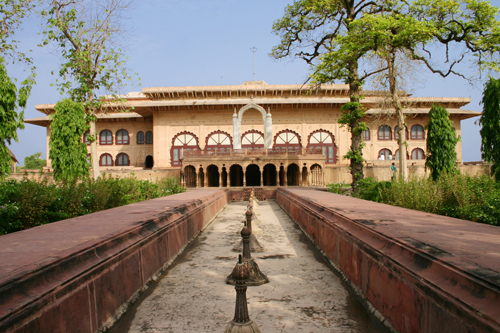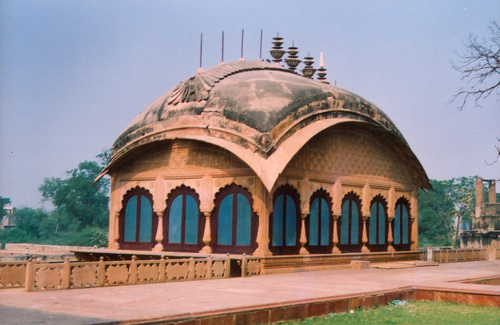The Deeg Bhawans, popularly known as Water-Palaces, were raised by the Jat rulers viz. Surajmal (A.D. 1756-63) and Jawahar Singh (1764-68). Built of sandstone slabs of pinkish colour and finely plastered, this architecture is often designated as the Jat style. The buildings include (i) Gopal Bhawan with two flanking pavilions, viz. Sawan and Bhadon Bhawans, (ii) Suraj Bhawan, (iii) Hardev Bhawan, (iv) Kishan Bhawan, (v) Kesava Bhawan, (vi) Nand Bhawan, (vii) Singh Pol, (viii) Central Garden and two tanks named Gopal Sagar and Rup Sagar. The architecture is basically of the trabeate order but the use of arcuate system has been made in certain cases. The general features are engrailed arches resting on ornate pillars, hypostylar halls, flat terraces, balconies and pavilions with Bengal roofs. Semicircular, trifoiled and pointed arches are also met. Though not very imposing in conception, each bhawan possesses a dignity and delicacy. Besides, the Kachcha Bagh, also known as Rani Bagh, served as royal garden for the local rulers. This garden is situated at the back of the Gopal Bhawan across the Gopal Sagar (tank). The garden is connected with the palaces through Singh Pol as well as Suraj Gate. There is a rectangular pavilion in the centre of the garden which is enclosed by plastered stone wall. Various fruit trees are grown in the garden. It is datable to eighteenth century AD.




 By Air : Agra
By Air : Agra By Bus : Deeg
By Bus : Deeg By Train : Deeg
By Train : Deeg